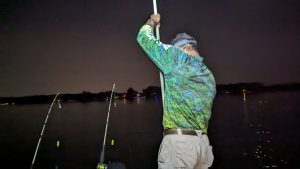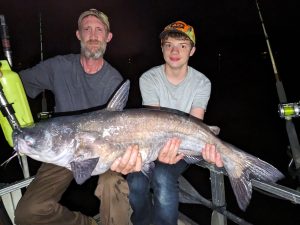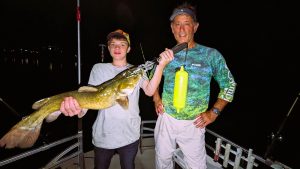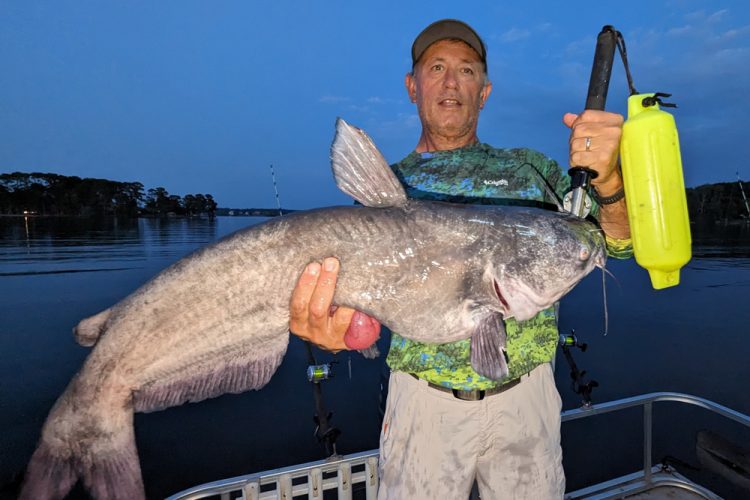Guide Rodger Taylor said having a plan for night fishing helps him put
big catfish in the boat. This one bit on the first set-up before he got all his rigs set.
Catfishing After Dark
Story and Photos By Terry Madewell
Catfish move to the shallows to feed at night. Fishermen with a good plan can find and catch them where they go to chow down.
Rodger Taylor from Rock Hill, South Carolina, said his philosophy of catfishing at night is akin to big-game hunting. Taylor employs an effective strategy to target his quarry in areas where they eat, using stealth and organization to make the catfish connection.
For Taylor, that connection is hooking rod-bending blue and flathead catfish on Lake Wylie, a Catawba River lake straddling the North and South Carolina border.
The 62-year-old Taylor is a full-time catfishing guide (Catfish On! Guide Service, 803-517-7828), and he’s developed specific, seasonal plans for year-round fishing success, especially for night-fishing adventures.

“I offer both day or night trips,” Taylor said, “The nocturnal hours are my favored times for consistent shallow-water action. Recreational boat traffic is minimized and I can usually fish how and where I prefer.”
Taylor said having his boat rigged to make fishing simple is paramount for night fishing.
“An organized boat at night is essential, and my pontoon boat has a place for everything,” he said. “I store equipment in accessible places. When I need a net or any tool after dark, having specific homes for every item keeps fishing simple. I employ subtle lighting to illuminate the boat, so watching rod tips and moving around is easy. I don’t light it up like downtown, however.”
Catfishing at night is often a game of patience, interspersed with frantic action.
“I make my first set-up prior to dark, so I can ensure everything is organized for the night, and that first set-up at dusk is often productive,” he said. “Long waits are rare when we’re fishing the right areas.
“I night fish via stationary set-ups targeting shallow water. Feeding catfish move toward the shallows to forage during low-light periods, and I target those areas. Being comfortable and able to chat while our heads are figuratively on a swivel watching rods makes the time fun, enjoyable and productive.”
Taylor uses long poles instead of anchors to hold his boat in position. The poles are held in place by metal rings permanently mounted to the boat. He runs the sharpened end of the pole though the ring and pushes it into the lake bottom.
“I do this on the front and back of the boat, and it holds securely,” he said. “My typical target depth for the boat is eight to 10 feet of water. This puts the boat at mid-depth range of my nocturnal fishing depths on Lake Wylie, minimizing noise and intrusion. That’s important when catfish are feeding nearby in shallow water.

“Standard anchoring techniques work fine, but for me, poles are easier, more efficient and stealthier.”
Taylor casts bait into water only a couple of feet deep near the shoreline, targets mid-depths and casts a couple rigs into deeper water. The bottom contour has noticeable depth change around these areas.
“A good example for a night set-up would be a point coming from the shoreline that gradually drops into deeper water,” he said. “That has fish-catching potential, but a point dropping into an old creek or river channel makes it a prime target.”
Channel bends near the shoreline tend to funnel forage and catfish into the shallows, making them good targets. Areas where the bottom substrate supports mussel beds or areas attractive to forage fish are prime choices as well.
“I prefer my nocturnal targets to have food for catfish, like a stacked dinner table at Thanksgiving,” he said. “Find this scenario and catfish will come.”
Catfish are attracted to those places to eat. Bites are frequent and typically aggressive. Because of his stealthy set-up, he doesn’t spook fish, and it’s common to hook catfish before he gets all eight rigs out.
On a nocturnal trip with Taylor in 2023, we fished four spots, caught multiple fish in all four and, on three of them, our first fish loaded on within a couple minutes of set-up, well before he got all his rigs out. Don’t plan on squeezing in a nap on Taylor’s boat just because the sun goes down.
Taylor targets blues and flatheads. Both are available in good numbers and sizes in Lake Wylie. The lake also has a healthy population of channel catfish, too. Taylor said it’s helpful to know the available catfish species and target each one specifically wherever you fish.

“Using the right bait for the target species is essential,” he noted. “I’ve fished a lot of lakes and have learned that bait from the lake I’m fishing is a good choice. At Lake Wylie, gizzard and threadfin shad are prime forage, as are white perch and bluegills. Cut or whole baits are productive, and I often use a variety of baits until I establish a pattern. If I were limited to just one bait, it would be fresh gizzard shad cut into half-dollar-sized chunks.”
The fresh shad catches both blues and flatheads, but he may employ a live bluegill or perch if he’s targeting a big flattie in a specific location.
Taylor gives a spot 30 to 40 minutes to produce. By targeting feeding fish, he expects bites, so he doesn’t linger if the bite is slow. If he experiences a good flurry of action that slows for 15 minutes, he’ll move.
Tackle is a final consideration. On Lake Wylie, he has the potential to hook big catfish, so Taylor employs 7-1/2-foot, medium-heavy rods, with 30-pound-test main line and 40-pound-test leaders. He uses 6/0 to 8/0 circle hooks and one-half to one ounce of weight.
“I love the peace and tranquility of night fishing,” Taylor said. “I like it even better when a rod doubles over and I hear the squeal of the drag with line peeling off the reel. On most nights, using the plan of attack I’ve just described, we get a healthy dose of both scenarios.”
(Terry Madewell of Ridgeway, S.C. has been an outdoor communicator for nearly 50 years. He holds a degree in Wildlife and Fisheries Management and has a long career as a professional wildlife biologist/natural resources manager. He’s passionate about sharing outdoor adventures with others.)



